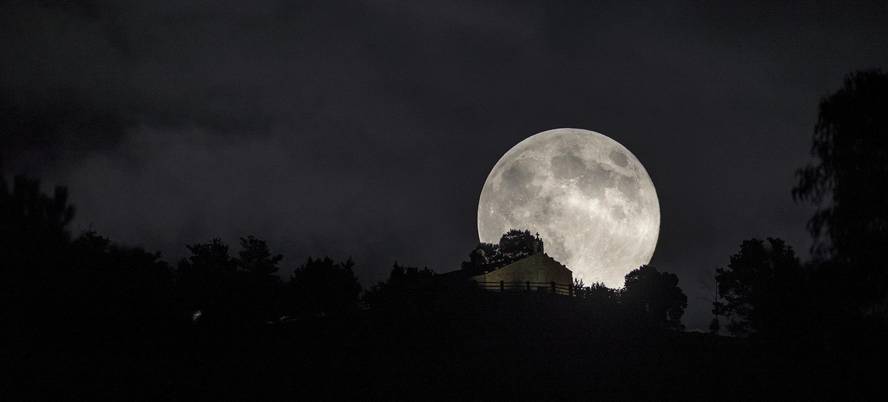On the meaning of the words Crescent/Diminishing Fourth
The axis of the Earth has a 23,5º inclination. That is why we see the Sun on high during the summer noon. Its maximum height is around the day of San Juan, solstice of summer. In winter the Sun is much lower at noon. Its lowest height is around Christmas Day, in the winter solstice. The difference between these two points is 47º anywhere (23.5º by two). The Moon circulates approximately on the same path as the Sun, being able to be about 5º above or below, due to the inclination of the orbit of the Moon with respect to the Earth's ecliptic. That is, sometimes the Moon goes up and sometimes down.
Leaving aside the technicalities as far as possible, I will try to explain the movements of the Moon in the sky. Let's take the new moon closer to the day of the summer solstice. In this phase we do not see the Moon because it is day near the Sun. Very high, therefore, as the Sun of that time. In the 14-day period that goes from here to a full moon (that is, in Basque the Crescent), the moon is losing height in the sky, since the full moon of early summer occupies the positions of the Sun in winter. That is the new sense that is meant to adapt to the word Fourth Waning, that is, the time when the Moon loses height in the sky every day, in our sky. Then, and always according to the new interpretation, Ilgora letorke, from the Full Moon of that time, which is gaining height every day (remember that in normal Basque this phase is called Moon in Menguante, since the illuminated part of the Moon is decreasing). In fact, for this new early summer moon to occur at the highest point, it must have a new moon on the day of solstice. As it normally is not, there is usually a slip. And even though the new Moon is the day of solstice, the 5th inclination of the orbit of the Moon generates another small gap. However, to understand the phenomenon gives us the same.
At the other end of the year, at the beginning of winter, the opposite occurs. The full moon is usually very high and the new below. At this time, according to the new interpretation and unlike the summer, the Moon in Fourth Waning would be the period from one moon to another. The Crescent Moon, without taking into account the aforementioned dephases, goes back to full. What happens throughout the year? Of all. To put two examples, around the spring equinox, the Waning Moon, according to the new interpretation, would go from the traditional Crescent Moon to the Waning Moon and vice versa the Crescent Moon. As for the autumn equinox, just the opposite.
Are those who say we misuse the words Creeping and Waning Fourth? I want to make clear from the beginning one thing: this is not a scientific debate, but a linguistic debate. The phenomenon to which it refers, that is, that the Moon moves more or less above (change of decline in technical language) has no specific term in astronomy, in any language. The orbit of the Moon has only ascending or descending nodes.
Moving the debate to the linguistic field, we find a serious problem. The typical meanings of the words Crescent and Diminishing Room are documented. Pello Zabala also uses the words Crescent and Ilbehera to designate the lunar phases in his book Nature (Alberdania, 2000). And the Dictionary of the Royal Academy of the Basque Language (EUSKALTZAINDIA) defines all dialects of the Basque language. Where are the evidence of the use of other meaning? They have not presented us any.
I think this entanglement is related to biodynamic agriculture. Biodynamic agriculture is based on the theories of the Austrian philosopher Rudolf Steiner (1861-1925), whose main driving force was Maria Thun. In the twentieth century. To know the nature of these ideas one can resort to a very significant writing in Thun, “Hinweise aus der Constellationsforschung für Bauern, Weinbauern, Gärtner und Kleingärtner” (Constellations and biological-dynamic agriculture) The idea of ascending/descending moon is related to this type of agriculture. Hence comes the question of fixing yourself in the circumstances of the Moon. In the book of Thun it is said, among other things, that in the descending Moon the contour of the roots of the plants is activated. Rudolf Steiner established in 1924 the principles of this type of agriculture. But beliefs about the right time to plant and plant trees or cut them are related to the usual phases of the Moon in Basque popular knowledge.
In any case, the subject to debate is not whether biodynamic agriculture is direct or not, but the meaning of the words Growing and Missing Fourth. Other territories have included biodynamic agriculture, but with new words like ascending moon, ascending moon and ascending moon. Here, for their part, those “above/below” of the Moon have been some of them which have related to the literal meaning of the words Crescent/Fourth Waning, without taking into account that in the mouth of the Basques those words have another meaning.
In any case, I find it difficult to believe that our ancestors did the work of the hamlet according to the circumstances of the Moon. It is relatively easy to know when the Moon rises and when it falls today: just look at the biodynamic calendars or use computer programs like the Stellarium. But yesteryear it was not so simple. It is easy to predict lunar phases, which have a period of 29.5 days, a synodic month, but not when the moon rises and when it falls. Two hundred years ago, for example, a farmer, to know the lunar phase, had only to look at the Moon. But, look at him, how do you know if he will go up or down in the next few days? It is not known.
But suppose, however, that the meaning “real” or “original” of Ilgora and Ilbehera is equivalent to that of ascending/descending moon of biodiesel agriculture. If so, the phenomenon that is so easily perceived, that of the lunar phases, would be patent in Basque. We have Full Moon and New Moon, but we would be nameless to indicate the intermediate phases, unlike other languages. It would be absurd.
"This entry #CultureCientífico 3. Participate in the festival"








